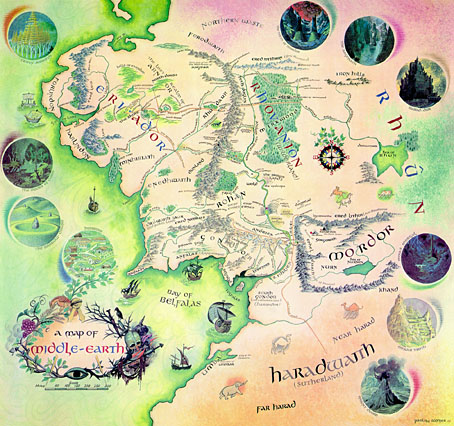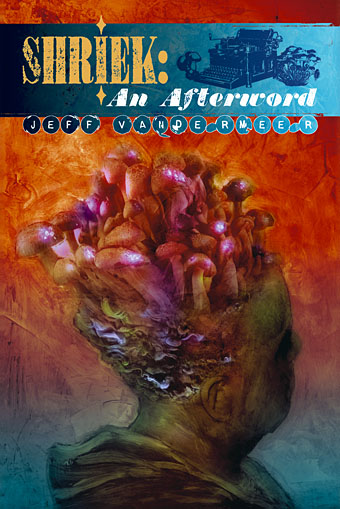Far from Gormenghast
| Mervyn Peake’s Collected Poems.
Tag: Mervyn Peake
Pauline Baynes, 1922–2008
Pauline Baynes, who died earlier this week, was for a long while the only Tolkien illustrator of note. Her work was approved by Tolkien himself but faded from view as the JRRT spin-off industry began to expand in the late Seventies and other artists quickly crowded the field, many of whom lacked her subtlety and sympathy for the material. It was her artwork which Allen & Unwin used on their single-volume edition of Lord of the Rings and in the late Sixties they also produced a poster of her Middle Earth map (above; complete version here). That poster hung on my bedroom wall and fascinated me with its view of the now over-familiar characters and the vignette details of various locations.
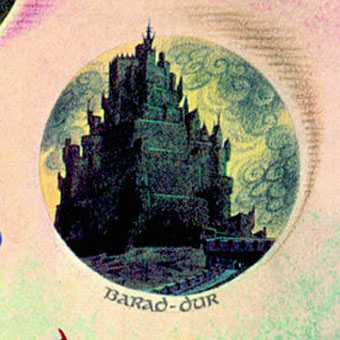
Those vignettes, such as her tiny rendering of Sauron’s Dark Tower, seemed at the time a perfect summation of Tolkien’s world and I still prefer her hulking Barad-dûr to the spiny monolith seen in Peter Jackson’s films. Her friendship with Tolkien led to a similar commission for maps and illustrations from CS Lewis and it’s as the illustrator of the Narnia books that she’s most celebrated. I never read Lewis’s work, and came to Lord of the Rings late, so the infatuation with this brand of heroic fantasy swiftly gave way to the ambivalent moralities of Michael Moorcock‘s Elric, Fritz Leiber‘s Lankhmar and Mervyn Peake’s Gormenghast. Her work wouldn’t have suited those writers but for Tolkien and Lewis she was ideal.
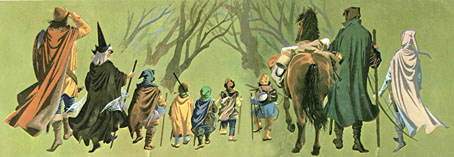
The Fellowship of the Ring from the Middle Earth map.
One of the newspaper obituaries notes:
It was somewhat to her chagrin that she developed a reputation over the years as an illustrator of mostly Christian works and, to redress the balance, one of her last creations (her “children” as she called them) was a series of designs for selections from the Qur’an, scheduled for publication in 2009.
These days Charles Williams is the writer who interests me still from the Oxford group known as “the Inklings”, of whom Tolkien and Lewis were the most famous members. Williams was also a Christian propagandist but his use of fantasy was more sophisticated and, in the extraordinary Many Dimensions (1931), he too managed to depart from the Christian sphere by blending HG Wells-style science fantasy with Islamic mysticism.
Brian Sibley wrote a Pauline Baynes obituary for The Independent and his blog features an excellent overview of her life and work.
Elsewhere on { feuilleton }
• The illustrators archive
Previously on { feuilleton }
• Mervyn Peake in Lilliput
Fungal observations
Seeing as Jeff VanderMeer and his publisher have made the cover for the new edition of Shriek: An Afterword public, I may as well do the same. The design is mine, the cover painting is by comic artist Ben Templesmith. The design and its integration with the book contents are more evident when you see the complete dust jacket, and the rest of the book, of course. Since these are still being proofed I’ll probably post them after publication. Meanwhile, the book has a reduction of 25% if you order a copy now.
Limited Edition: 500 signed numbered hardcovers
Expected Publication Date: Second quarter 2008“Like some delicious mashup of H.P. Lovecraft, Mervyn Peake, and L. Frank Baum, but with his own verbal dexterity and perverse ingenuity…An affecting narrative about love, art, sibling rivalry, commerce, history, and some really nasty ’shrooms.” The Washington Post Book World
A year’s best selection of The San Francisco Chronicle, The Austin Chronicle, and SF Site, World Fantasy Award winner Jeff VanderMeer’s Shriek: An Afterword is a triumphant return to the author’s imaginary city of Ambergris—the setting of his critically acclaimed, best-selling City of Saints & Madmen.
Shriek: An Afterword relates the scandalous, heartbreaking, and horrifying secret history of two squabbling siblings and their confidantes, protectors, and enemies. Narrated with flamboyant intensity and under increasingly urgent conditions by ex-society figure Janice Shriek, this afterword presents a vivid gallery of characters and events, emphasizing the adventures of Janice’s brother Duncan, a historian obsessed with a doomed love affair and a secret that may kill or transform him; a war between rival publishing houses that will change Ambergris forever; and the gray caps, a marginalized people armed with advanced fungal technologies who have been waiting underground for their chance to mold the future of the city.
Experience the beautifully strange novel that received a starred review in Publishers Weekly and was praised by, among others, Elizabeth Hand, Gene Wolfe, Zoran Zivkovic, Hal Duncan, and Jeffrey Ford.
“Shriek: An Afterword further established Jeff VanderMeer as the finest fantasist of his generation.” The Austin Chronicle
“Five stars! A stunning and very different fantasy novel.” BBC Focus Magazine
“In the telling, Shriek: An Afterword is an exceptional novel, a tapestry of fine writing, deep psychological insight, and acute narrative excitement…. a dark fantasy of tremendous distinction.” Locus
Previously on { feuilleton }
• Shriek: The Movie
• New things for April II
• Jeff on Bldgblog
• An announcement redux
• City of Saints and Madmen
Mervyn Peake in Lilliput
This month I’ve been redesigning the Savoy Books edition of The Exploits of Engelbrecht by Maurice Richardson, in preparation for a reprint. This has involved scanning the covers of the issues of Lilliput, the magazine where Richardson’s tales of the dwarf surrealist sportsman first appeared, and one number of these, from May 1950, also includes a feature about nursery rhymes illustrated by Mervyn Peake. The paintings were reprinted in Mervyn Peake: The Man and his Art in 2006 but shrunk onto a single page so this is a chance to see them at a larger size. Also reproduced below is the accompanying article by Leslie Daiken and the Arcimboldo-style cover by Ronald Ferris. Some of the earlier covers by Walter Trier—all of which featured a man, a woman and a dog in a variety of guises—can be seen at VTS.
Update: For more about Mervyn Peake, see also Peake Studies.
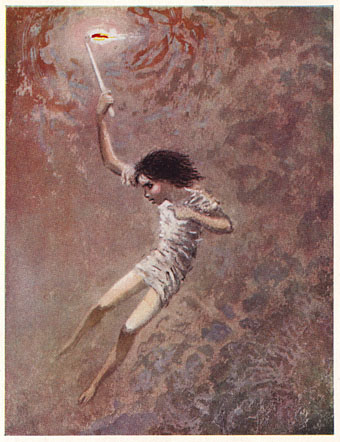
“How many miles to Babylon?”
“Three score miles and ten.”
“Can I get there by candle-light?”
“Yes, and back again.
If your heels are nimble and light
You may get there by candle-light.”
The art of Harold Hitchcock
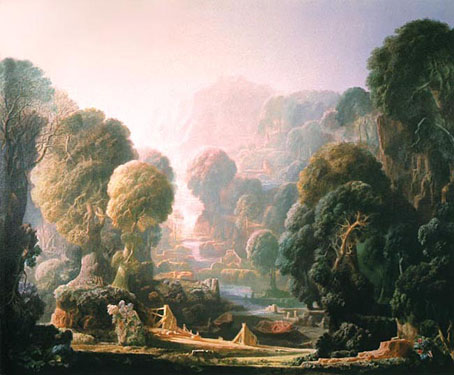
Sunrise in a Valley (1974).
It’s difficult to say whether the work of Harold Hitchcock (born 1914) is rarely seen in his native country because of those British art critics who’ve often regarded fantastic or sacred themes with suspicion—or whether it’s merely because people find his work to be bad. Sometimes the latter accusation appears to be a disguise for the former belief, especially among those who follow the pack rather than drawing their own conclusions. At times the English Channel has acted as an aesthetic as well as a physical barrier. British art never quite got to grips with Surrealism, despite the best efforts of Roland Penrose and others, while Symbolism was almost exclusively a Continental movement whose existence was largely expunged from later art histories; the 1959 Penguin Dictionary of Art and Artists, for instance, has entries for minor groupings such as the Hudson River School and the Nazarenes, but no entry at all for Symbolism. Fantasy was allowable in illustration but not elsewhere; no wonder Mervyn Peake took up writing.
So much for polemic. Hitchcock’s work comprises very detailed landscapes that present a Claude Lorraine-like approach to light with more Modernist forays reminiscent of Expressionist painters such as Franz Marc. His fanciful works remind me of his Surrealist contemporary Leonora Carrington, with their creation of a self-contained, often naive, private world. Hitchcock lives in South Devon and was still active three years ago when the BBC reported his 90th birthday. The American exhibition mentioned in that news story took place at the Phillips Gallery, Carmel, CA and their site has three pages of (rather blurred) examples of his luminous work.
Update: The official Harold Hitchcock site
• Harold Hitchcock by Leonard Hitchcock
• Catching the Light by Emmanuel Williams
Elsewhere on { feuilleton }
• The fantastic art archive

